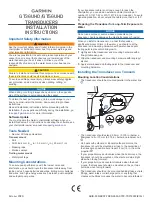
EN: Installation instructions
Information
This is the GE Door-Window Sensor 868 Mhz Installation
Instructions for models RF300NW8, RF300NW8B, NX-850N-I and
NX-851N-I.
The Universal Transmitter is provided with a 3-volt DL 123A
Lithium Battery and an external magnet. It contains an internal
reed switch, connections for an external open or closed contact
loop and a cover and pry off tamper switch. Two jumpers allow
you to select internal or external reed, and normally open or
closed external loop.
This Universal Transmitter is a single address device and will
transmit Alarm, Tamper, Restore, and Low Battery codes. It also
transmits a "supervisory" signal every 15 minutes to the receiver
indicating its status and presence.
Explanation of figures
1
Opening the transmitter housing
A Cover
B Slot
2
Securing the transmitter housing
3
Universal transmitter layout
C Mounting
hole
D Magnet
E Aligning
mark
F Battery
holder
G Reed
contact
H External
contact
input
I
J2, external contact
J
J3, reed contact
K Mounting
hole
Jumpers
J2 - External contact (fig. 3, I)
J3 - Reed contact (fig. 3, J)
Normally open (default)
Reed enabled (default)
Normally closed
Reed disabled
Note:
You should only use the internal reed OR the external
contact.
Installation
Recommended mounting surfaces include plastic, wooden and
aluminium door/window frames. Mounting on steel surfaces must
be avoided.
The maximum gap between the case of the transmitter and the
external magnet cannot be greater than 10 mm. For applications
requiring a gap of 10 mm or greater, use an external contact
switch connected to the external loop circuit and disable the
internal reed switch.
The Universal Transmitter should be tested at the intended
location before permanently mounting to make sure that proper
signal transmissions can be made. Consult the appropriate
Control
Panel Instructions
for programming and test details.
Opening, closing and mounting
To remove the sensor cover (fig. 1, A), press a small screwdriver
into the slot (fig. 1, B) at the end of the sensor while lifting the
cover. Make sure the unit and magnet can be aligned properly in
the intended mounting position and the cover can be
opened/closed after mounting. Mount the unit with the two
flat
head screws (included) using the slotted mounting hole in the base
(fig. 3, K) and the mounting hole next to the tamper switch
(fig. 3, C).
Replace the cover by hooking in the "lower end" first and then
snapping the opposite cover end into place. Secure it (fig. 2) with a
self-taping screw (included).
EN-compliant installation
In order to install your wireless product according to EN50131-1,
please screw the transmitter housing according to fig. 2.
Use of the internal reed (supplied)
It is important that the magnet (fig. 3, D) is installed in such a way
that it is aligned with the mark (fig. 3, E) on the detector. Verify that
the reed switch (fig. 3, G) is enabled, and jumpers J2 (fig. 3, I) and
J3 (fig. 3, J) are in the standard position.
Use of an external contact loop
The transmitter can monitor "open circuit" or "closed circuit"
contacts but not both at the same time. Select and set Jumper
J2 (fig. 3, I) for "Normally Open" or "Normally Closed" loop. An
alarm will be transmitted when the contact opens (J2 in "Normally
Closed" position) or when the contact is closed (J2 in "Normally
Open" position). When the loop contact restores, a restore event
will be transmitted. Connect the external loop contact to the two
way screw terminal block (fig. 3, H). Jumper J2 should be set to the
"Normally Open" position (default position) if the external loop is
not used. Jumper J3 should be set to "reed disabled".
Note:
In EN/INCERT approved intrusion security applications the
usage of the external input is prohibited.
Use of pry-off tamper
To allow the functioning of the pry-off tamper, you need to fit a
screw in the mounting hole (fig. 3, C). If the sensor is removed from
the wall the plastic part at the back of the base and a part of the
PCB breaks out.
Battery installation and removal
Insert the battery into the battery holder (fig. 3, F), observing
correct polarity.
Caution:
Batteries can explode or cause burns if disassembled,
recharged or exposed to fire or high temperature. Please dispose
of old batteries properly.
Upon indication of low battery, please remove the battery from its
holder. Dispose the used battery according to the enclosed
WEEE instructions and/or local government authorities.
2 of 8
P/N KEM-PK27107D • REV 00.02 • ISS 24NOV08


























